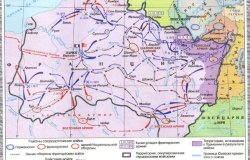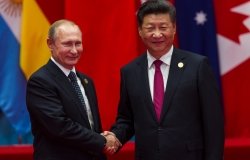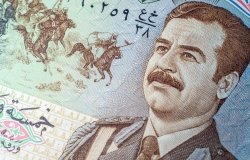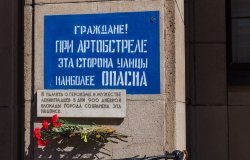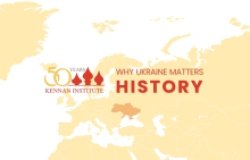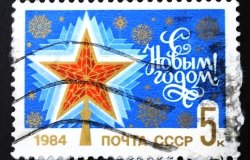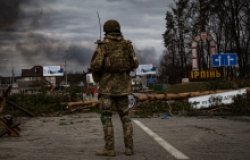165. Televiziunea Romana: Regional Issues and Ethnic Minorities In Cluj
Prior to the revolution of December 1989, communist-controlled Romanian Radio and Television was the country's only broadcasting station. The government's incessant quest to save energy limited TV programming to two hours a day, from 8:00 to 10:00 pm. Day in and day out, the program began with a newscast on the activities of Nicolae Ceausescu, the president of Romania, and his wife, Elena. Had he done something important, this would be the only news that day. The first item to be sacrificed in this case was the international news. Sometimes the entire newscast or even the entire program was dedicated to Ceausescu's "extraordinary deeds and brilliant speeches."
This media nightmare was one of the reasons that Romanians took to the streets in December 1989. The people could no longer tolerate the absolute lack of decent television programming compounded by the general lack of freedom of the press. They simply refused to let themselves be fooled any more.
Romanian Radio and Television operated five regional radio stations. Fear that these stations might get too independent led Ceausescu to close them down in 1985. The audio archive was loaded into freight trucks and taken to the warehouse of a prison near the capital city of Bucharest, and the employees were laid off.
As soon as the 1989 December revolution started, the former employees of Radio Cluj reported to their old place of work and started airing radio programs. They also decided to try something that had never been tried before in Cluj: television. Radio Cluj reporters teamed up with photographers and engineers in an old production van and aired the first local TV broadcast in Cluj and in Romania on January 3, 1990. Using donated home video equipment, they managed within a few days to air local programs on a regular basis in both Romanian and Hungarian. These programs were broadcast in the opening program on national TV, on the same frequency but to a regional audience.
The most impressive thing is that all the former radio and production employees reported to work instantly; no one summoned them. The desire and need for a free press was immense. People simply absorbed like a sponge everything written in the papers or aired on radio or TV in those days of enthusiasm and hope. A strong wind of change was blowing throughout the country.
The newly-born Cluj TV station continued on its own until the government-run Romanian Radio and Television decided that regional TV stations were a good idea. The Cluj station received some old U-matic equipment and some cameras, but production went on for quite some time using mainly non-professional cameras and recorders. Finally in 1994, Romanian TV approved a major investment plan and professional Beta equipment was purchased for both studio and camera crews.
Currently, there are three regional TV stations in Romania and they all belong to the national television company. These regional stations cover news, sports, cultural, and economic events across an entire region. For instance, TVR-Cluj covers Transylvania, TVR-Iasi covers Moldova, and TVR-Timisoara covers Banat. For the time being, all three regional stations air their programs on the national network. For that reason, the programs are very short--only one hour daily during weekdays on TVR Channels 1 and 3; and five hours every other weekend on both Channels 1 and 2. Obviously, the hours are inconvenient and too limited. TVR-Cluj airs its program from 9:00-10:00 am; TVR-Iasi from 10:00-11:00 am; and TVR-Timisoara from 11:00- noon. This situation should change for the better when the regional stations are granted independent frequencies. Then they will be able to air programs on their own schedule and will no longer be constrained by the national network.
The essential difference between the national TV regional stations and local private stations is that the private stations cover a wider area of about 150 square miles, inhabited by over seven million people and reaching even the most remote villages. The national regional stations are more limited: TVR-Cluj, for example, covers just the Cluj-city area. There is also the basic funding difference between public and commercial stations. The public station often must air programs that are not very attractive to advertising, such as the cultural, educational, and ethnic minority-oriented programs.
Why does the issue of advertising arise with a public TV regional station? The answer is the very peculiar funding system in Romania. Romanian national television gets support from public subscriptions, government subsidies, and advertising. The regional public stations receive some funding from national TV, but they have to raise most of their money from advertising in order to function properly. The inconvenient air times make this an almost impossible task, especially considering the high and inflexible fees imposed by the national TV company. Consequently the incentive for launching the regional program as soon as possible is very strong.
Another difficulty is the quasi-inefficiency of the current regional programming. There are inherent problems with airing local programs on the national network. What should such a program look like and who is the audience? One cannot focus on local matters in detail because the national audience would not be interested. On the other hand, the regional audience is lost if the program does not probe deeply into local issues.
Cluj-Napoca is often referred to as the heart of Transylvania. As far as its area and population are concerned, the Cluj-Napoca metropolitan area (Kolozsvar in Hungarian and Klausenburg in German) is the biggest municipality in Transylvania and one of the biggest and most important cities in Romania. Located on one of the old axes of communication linking Western Europe with the eastern and southern parts of the continent, it is easy to understand why Radio Cluj and later TV-Cluj, which featured local personalities, were considered cultural stations. Both radio and TV archives contain priceless recordings of Transylvania's greatest writers, artists, actors, directors, opera singers, composers, scientists, etc. Both the Romanian and Hungarian areas have striven to preserve and promote the different aspects of Transylvanian culture.
But the change in times has brought something new: competition. There are five TV stations in Cluj at present. To stay afloat, the stations have had to diversify their programs, become more involved in the life of the community, and develop more active coverage of news, current affairs, sports, and entertainment. Cultural programming is still an element, of course, but it is more "TV-like" than it used to be.
One year ago, a new management team was appointed for TVR-Cluj. Since then it has tried to update the station to modern television standards and develop the image of a dynamic, active, responsive, modern, and competitive station. New departments for program development and sales have been added, and the station is constantly trying to produce better and more interesting programs. Apart from the American TV shows, it produces a wide variety of its own programs, from news to entertainment shows and classical concerts. TVR-Cluj does not have the money that privately-owned stations have, but it tries to be both news leader and producer of programs that others cannot or will not produce. Programs are broadcast in three languages; Romanian, Hungarian and German, and a special program for the Jewish community is currently in production.
The minorities programming department is the largest editorial department in the TVR-Cluj station. The structure and content of the Hungarian and German programs are entirely decided within the department and basically have the structure of any TV program in the world. They open with the news and then go on to subjects of interest for the Hungarian or German communities. Minorities programs comprise almost 30 percent of the entire TVR-Cluj schedule.
Constantin Trofin spoke at an EES noon discussion on April 2, 1998.
About the Author
Constantin Trofin
Read More
Global Europe Program
The Global Europe Program is focused on Europe’s capabilities, and how it engages on critical global issues. We investigate European approaches to critical global issues. We examine Europe’s relations with Russia and Eurasia, China and the Indo-Pacific, the Middle East and Africa. Our initiatives include “Ukraine in Europe” – an examination of what it will take to make Ukraine’s European future a reality. But we also examine the role of NATO, the European Union and the OSCE, Europe’s energy security, transatlantic trade disputes, and challenges to democracy. The Global Europe Program’s staff, scholars-in-residence, and Global Fellows participate in seminars, policy study groups, and international conferences to provide analytical recommendations to policy makers and the media. Read more
